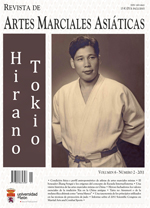Auto-eficácia e rendimento do chute circular do taekwondo
DOI:
https://doi.org/10.18002/rama.v9i2.1323Palavras-chave:
Artes marciais, desportos de combate, chute, auto-eficácia específica, auto-eficácia geral, biomecânicaEntidades:
Catholic University of Valencia (2011-007-002).Resumo
O desenvolvimento de escalas de auto-eficácia permite a análise das perceções dos atletas e o exame da relação entre as ditas perceções e o rendimento. O objetivo do estudo foi: (1) desenvolver uma escala específica de auto-eficácia para uma técnica do taekwondo: o chute circular; e (2) analisar o rendimento desportivo e a sua relação com os resultados das duas escalas de auto-eficácia (específica e geral), em função do gênero dos atletas. Participaram neste estudo 43 taekwondistas (33 homens e 10 mulheres). Administraram-se as escalas de auto-eficácia Física (PSE) e Específica (RKSES). Os dados de rendimento (força de impacto e tempo total de resposta) foram obtidos mediante o golpe dos esportistas a um objetivo instrumentado. Os resultados mostraram que a escala de auto-eficácia específica tem uma maior fiabilidade e pode prever o rendimento desportivo dos homens e mulheres. Os homens obtiveram pontuações de auto-eficácia e rendimentos mais altos do que as mulheres. O treino psicológico das mulheres deveria se focar em melhorar a sua perceção de auto-eficácia com o objetivo de aumentar o seu rendimento com o chute circular. Esta escala específica de auto-eficácia para o taekwondo facilita a informação empírica dos treinadores, psicólogos desportivos e investigadores, permitindo-lhes prever o rendimento desportivo dos atletas com o chute circular.
Downloads
Métricas alternativas
Referências
Bandura, A. (1997). Self-efficacy. The Exercise of Control. New York: Freeman and Company.
Bandura, A. (2002). Social cognitive theory in cultural context. Applied Psychology: An International Review, 51, 269-290.
Cohen, A. (1988). Statistical power analysis for the behavioural sciences (2nd ed.). Hillsdale, NJ: Lawrence Erlbaum.
Devenport, T. (1997) Perceptions of the contribution of psychology to success in elite kickboxing. Journal of Sports Sciences and Medicine, CSSI, 99-107.
Estevan, I., Alvarez, O., Falco, C., Molina-García, J., & Castillo, I. (2011). Impact force and time analysis influenced by execution distance in a roundhouse kick to the head in taekwondo. Journal of Strength and Conditioning Research, 25, 2851-2856.
Falco, C., Alvarez, O., Castillo, I., Estevan, I., Martos, J., Mugarra, F., & Iradi, A. (2009). Influence of the distance in roundhouse kick’s execution time and impact force in Taekwondo. Journal of Biomechanics, 42, 242-248.
Falco, C., Molina-García, J., Álvarez, O., & Estevan, I. (2013). Effects of target distance on select biomechanical parameters in taekwondo roundhouse kick. Sport Biomechanics, 12, 324-333.
Feltz, D. L., Short, S., & Sullivan, P. (2008). Self Efficacy in Sport: Research and Strategies for Working with Athletes, Teams and Coaches. Champaign: Human Kinetics.
Hu, L., McAuley, E., & Elavsky, S. (2005). Does the Physical Self-Efficacy Scale Assess Self-Efficacy or Self-Esteem? Journal of Sport and Exercise Psychology, 27, 152-170.
Loevinger, J. (1957). Objective test as instruments of psychological theory. Psychological Reports, 3, 635-694.
Lázaro, I., & Villamarín, F. (1993). Capacidad predictiva de la auto-eficacia individual y colectiva sobre el rendimiento en jugadoras de baloncesto [Predictive capacity of individual and collective self-efficacy in female basketball players’ performance]. Revista de Psicología del Deporte, 4, 27-38.
Lane, A. M. (2002). Relationships between performance toward accomplishment and self-efficacy in amateur boxing. Perceptual and Motor Skills, 94, 1056.
Menescardi, C., Bermejo, J. L., Herrero, C., Estevan, I., Landeo, R., & Falco, C. (2012). Diferencias técnico tácticas en taekwondistas universitarios según sexo y categoría de competición [Technical tactical differences among university level taekwondo competitors by gender and weight division]. Revista de Artes Marciales Asiáticas, 7(2), 1-11. Retrieved from http://revpubli.unileon.es/ojs/index.php/artesmarciales/article/ view/82
Morales-Negron, H. (2008). Self-efficacy and state anxiety during mandatory combatives training. Archives of Budo, 4, 26-31. Retrieved from http://www.archbudo.com/abstracted. php?level=5&ICID=867239
Moritz, S. E., Feltz, D. L., Fahrbach, K. R., & Mack, D. E. (2000). The relation of self-efficacy measures to sport performance: A meta-analytic review. Research Quarterly of Exercise and Sport, 71, 280-294.
Nakagawa, S., & Cuthill, I. C. (2007). Effect size, confidence interval and statistical significance: a practical guide for biologists. Biological Reviews, 82, 591-605.
Pelegrín, A., & Jara, P. (2009). Manipulación de submodalidades de la representación mental en el trabajo psicológico con taekwondistas: una intervención en el marco de la P.N.L [Submodalities manipulation of the mental representation at psychological work with taekwondists: an intervention in the context of P.N.L.]. Cuadernos de Psicología del Deporte, 9, 39-51.
Ryckman, R. M., Robbins, M. A., Thornton, B., & Cantrell, P. (1982). Development and Validation of a Physical Self-Efficacy Scale. Journal of Personality and Social Psychology, 42, 891-900.
Yang, G., & Pargman, D. (1993). An investigation of relationship among sport-confidence, self-efficacy and competitive anxiety and their ability to predict performance on a karate skill test. In S. Serpa, J. Alves, V. Ferreira, & A. Paula-Brito, (Eds.), Proceedings of the 8th World Congress of Sport Psychology (pp. 968-972), Lisboa, Portugal.
Downloads
Publicado
Como Citar
Edição
Secção
Licença
Direitos de Autor (c) 2014 Isaac Estevan, Octavio Álvarez, Coral Falcó, Isabel Castillo

Este trabalho encontra-se publicado com a Licença Internacional Creative Commons Atribuição-NãoComercial-CompartilhaIgual 4.0.
Os autores que publicam nesta Revista estão de acordo com os seguintes termos:
- Os autores cedem, de forma exclusiva, os direitos de exploração (reprodução, distribuição, comunicação pública, transformação) à Universidade de Léon, podendo estabelecer, em separado, acordos adicionais para a distribuição não exclusiva da versão do artigo publicado na Revista (por exemplo: alojar no repertório institucional ou publicá-lo num livro), com o reconhecimento da publicação inicial nesta Revista.
- O trabalho encontra-se na Creative Commons Attribution-Non Commercial-Share Alike 4.0 International License. Pode-se consultar aqui o resumo e o texto legal da licença.
- Permite-se, e sugere-se, que os autores difundam electronicamente as versões pré-impressão (versão antes de ser avaliada) e pós-impressão (versão avaliada e aceite para publicação das suas obras antes da sua publicação), favorecendo a sua circulação e difusão, e com ela o possível aumento da sua citação e alcance pela comunidade académica.











